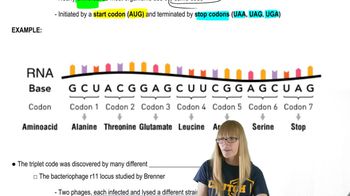Some proteins are composed of two or more polypeptides. Suppose the DNA template strand sequence 3′-TACGTAGGCTAACGGAGTAAGCTAACT-5′ produces a polypeptide that joins in pairs to form a functional protein.
What term is used to identify a functional protein like this one formed when two identical polypeptides join together?
Ch. 9 - The Molecular Biology of Translation
Chapter 9, Problem 2
In the experiments that deciphered the genetic code, many different synthetic mRNA sequences were tested.
Describe how the codon for phenylalanine was identified.
 Verified step by step guidance
Verified step by step guidance1
span>Step 1: Understand the context of the experiment. The genetic code was deciphered using synthetic mRNA sequences to determine which amino acids correspond to which codons.</span
span>Step 2: Recognize the role of Nirenberg and Matthaei's experiment. They used a cell-free system to translate synthetic mRNA into proteins.</span
span>Step 3: Identify the specific synthetic mRNA used. In this case, a poly-U mRNA sequence (UUUUU...) was used in the experiment.</span
span>Step 4: Analyze the results of the translation. The poly-U mRNA directed the synthesis of a polypeptide consisting entirely of phenylalanine.</span
span>Step 5: Conclude the identification process. The experiment demonstrated that the codon UUU codes for the amino acid phenylalanine.</span

Verified video answer for a similar problem:
This video solution was recommended by our tutors as helpful for the problem above.
Video duration:
3mWas this helpful?
Key Concepts
Here are the essential concepts you must grasp in order to answer the question correctly.
Codons
Codons are sequences of three nucleotides in mRNA that correspond to specific amino acids or stop signals during protein synthesis. Each codon is crucial for translating the genetic information encoded in DNA into functional proteins. Understanding codons is essential for deciphering how genetic information is expressed and how specific amino acids, like phenylalanine, are incorporated into proteins.
Recommended video:
Guided course

The Genetic Code
Synthetic mRNA
Synthetic mRNA refers to artificially created messenger RNA sequences used in experiments to study the genetic code. By introducing these synthetic mRNA sequences into a system, researchers can observe which amino acids are produced, allowing them to identify the corresponding codons. This method was pivotal in determining the specific codon that codes for phenylalanine.
Recommended video:
Guided course

mRNA Processing
Amino Acid Translation
Amino acid translation is the process by which the sequence of codons in mRNA is translated into a sequence of amino acids, forming a protein. This process occurs during translation, where ribosomes read the mRNA and tRNA molecules bring the appropriate amino acids. Identifying the codon for phenylalanine involved determining which specific codon sequence led to the incorporation of phenylalanine during this translation process.
Recommended video:
Guided course

Translation Elongation
Related Practice
Textbook Question
305
views
Textbook Question
Some proteins are composed of two or more polypeptides. Suppose the DNA template strand sequence 3′-TACGTAGGCTAACGGAGTAAGCTAACT-5′ produces a polypeptide that joins in pairs to form a functional protein.
What is the amino acid sequence of the polypeptide produced from this sequence?
284
views
Textbook Question
In the experiments that deciphered the genetic code, many different synthetic mRNA sequences were tested.
What was the result of studies of synthetic mRNAs composed exclusively of cytosine?
392
views
Textbook Question
In the experiments that deciphered the genetic code, many different synthetic mRNA sequences were tested.
What result was obtained for synthetic mRNAs containing AG repeats, that is, AGAGAGAG...?
295
views
Textbook Question
In the experiments that deciphered the genetic code, many different synthetic mRNA sequences were tested.
Predict the results of experiments examining GCUA repeats.
290
views
